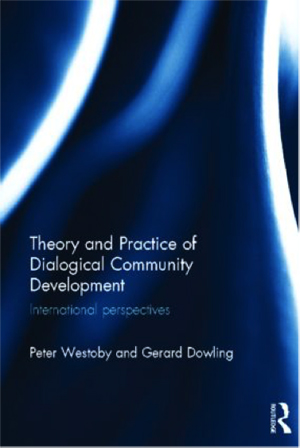DARREN CRONSHAW looks at a “deeply engaging” guide which can be used to help churches and church leaders engage with their communities at a deeper level…

Peter Westoby and Gerard Dowling
Theory and Practice of Dialogical Community Development: International Perspectives
Routledge, London, 2013.
ISBN-13: 978-1138838215

Theory and Practice of Dialogical Community Development is a deeply engaging and wide reaching textbook for community development students and practitioners, but relevant also for church leaders, Christian activists and theological educators interested in best practice for community engagement.
My denominational tribe, the Baptist Union of Victoria, recently started “Innovate” as a formation process for social entrepreneurs and community development activists. We realise churches need new faces and that to reach people we have not been reaching, we need to do things we have not done before. We want to encourage new projects that more immediately engage with the needs of our communities. When I asked community development experts what resources we should read and use, one of the top resources they referred me to was the soulful and dialogical community development approach of Queensland activists and teachers Paul Westoby and Gerard Dowling.
Westoby is senior lecturer in community development at Queensland University and has consulted internationally with Community Praxis Co-operative. Dowling works in social policy with Brisbane City Council. Both have 20-plus years of local grassroots community development experience in Brisbane. One of the most valuable aspects of the book is the authors’ reflection on their own experience and the stories of others. They also draw on a range of inspiration from Freire, Gandhi, Buber, Jung, Nouwen and others, and evaluate what we can learn from frameworks such as sustainable livelihoods, community-driven and assets-based community development. Basically, they critique the increasingly dominant modernist and technical philosophies of community development that reduce it to shallow techniques for solving community problems. They argue instead for a distinctly soulful approach that prioritises hospitality, dialogue and depth. Instead of experts flying in with prepared solutions to problems, they advocate moving in long-term with a commitment to listen and learn with local people, and to work alongside others for positive and long-lasting social change. They describe how a dialogical approach can transform economic, political, social, cultural and ecological concerns.
I especially appreciated the challenge to reclaim love in our practice, and to prioritise curious and critical questioning and a commitment to ask for and understand the other’s stories. The book appeals for attentiveness to relationships and place, and working with rather than for groups on the margins. The authors offer analysis of community development tools they have found valuable; for example, community-owned analysis, careful conflicting and people’s organisations. Their social analysis includes critique of forces that work against social change, such as the tendency of therapeutic culture to help people personally accept their situation rather than band together with others and advocate for change. Their stories show the wisdom of working courageously yet patiently from the grassroots (with lots of fruitful “grass” but also “roots” to make the work sustainable).
My favourite material was chapter six – ‘Dialogue and training for transformation’ – which offers a wealth of material for teaching and training. Borrowing Martin Buber’s term “possibilitator”, the writers describe the learning journey of offering groups space to dream about new directions to dare to think and act differently. To cultivate “imaginative literacy”, they urge avoiding overreliance on technology (for example, using more butcher’s paper and pens and less Powerpoint presentations). They discuss different training methods – experiential, elicitive, spiral, participatory learning and action, and deconstructive conversation, basically always beginning with listening to and grappling with experience and stories and drawing out implications for action to trial and learn from. There is a magic in inviting together groups of catalysts for transformative work and inviting them to make space for silence and dreaming, and for listening to learn from and share stories that ignite the imagination. Westoby and Dowling describe best practice in how to host this kind of experience, and how to seek the mandate from participants for being open to become possibilitators and the challenges that brings.
The book drove home for me the importance of this work: “[W]hat is crucial to effective community development is not lots of money; neither is it buildings and infrastructure – clinics, schools, roads or water. Instead what is crucial is the quality, creativity and analysis of people who dream of a better world for their shanty-towns, neighbourhoods or villages and want to take some form of public, collective and transformative action.”
Theory and Practice of Dialogical Community Development is a deeply engaging and wide reaching textbook for community development students and practitioners, but relevant also for church leaders, Christian activists and theological educators interested in best practice for community engagement.
This review was originally published in Australian eJournal of Theology 22:3 (December 2015), 217-218.
To buy this book, follow this link – Theory and Practice of Dialogical Community Development: International Perspectives





